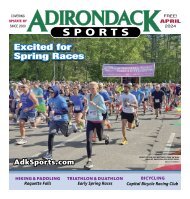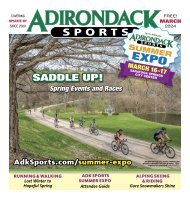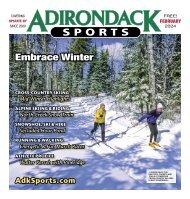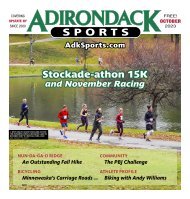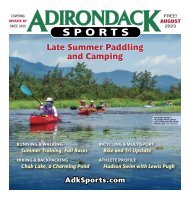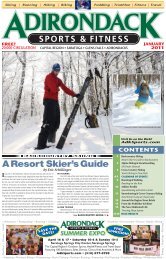Adirondack Sports November 2020
IN THIS ISSUE: 1 – Mountain Biking: Saratoga Shredders Girls Mountain Bike Club 3 – Running & Walking: Thanksgiving Reimagined 5 – News Briefs &From the Publisher 7 – Hiking & Snowshoeing: The Secret Views of Eleventh Mountain 9 – Athlete Profile: Skiing with Jack & Cathy Hay 12-14 – CALENDAR OF EVENTS: Find Races, Events & Things to Do! 15 – Hiking, XC Skiing & Snowshoeing: Prepare for Late Fall Adventures 16 – Alpine Skiing: Willard, The Little Mountain That Could 17 – Bicycling: Winter Riding Options 19 – Run, Walk & Snowshoe: Best Bets for Winter Running
IN THIS ISSUE:
1 – Mountain Biking: Saratoga Shredders Girls Mountain Bike Club
3 – Running & Walking: Thanksgiving Reimagined
5 – News Briefs &From the Publisher
7 – Hiking & Snowshoeing: The Secret Views of Eleventh Mountain
9 – Athlete Profile: Skiing with Jack & Cathy Hay
12-14 – CALENDAR OF EVENTS: Find Races, Events & Things to Do!
15 – Hiking, XC Skiing & Snowshoeing: Prepare for Late Fall Adventures
16 – Alpine Skiing: Willard, The Little Mountain That Could
17 – Bicycling: Winter Riding Options
19 – Run, Walk & Snowshoe: Best Bets for Winter Running
Create successful ePaper yourself
Turn your PDF publications into a flip-book with our unique Google optimized e-Paper software.
BICYCLING<br />
NOVEMBER <strong>2020</strong> 17<br />
Winter<br />
By Dave Kraus<br />
It doesn’t take a professional meteorologist<br />
to see that the traditional cycling<br />
season is over in upstate New York.<br />
The golds and reds of autumn have turned<br />
brown and the mercury is plunging.<br />
But that doesn’t mean you can’t still<br />
pedal your way to cardio fitness, or hold<br />
onto those gains you’ve made with the bike<br />
you bought, or the one you pulled out of<br />
the basement to cope with Covid lockdown<br />
induced stress. There are still plenty of<br />
options to ride outdoors, at home, or at the<br />
gym with others or by yourself. Let’s take a<br />
look at some of them.<br />
Keep riding outdoors. Yes, it can get<br />
cold and dark and messy. But there are still<br />
plenty of ways to take your ride outside.<br />
Ride the bike you already have with proper<br />
preparation and clothing. For tips on how to<br />
do that, see our story in the October issue<br />
at adksports.com/<strong>2020</strong>-10-bicycling. Keep<br />
in mind that safety and visibility are more<br />
important in the winter months with more<br />
hours of darkness and drivers who may not<br />
be expecting to see cyclists on the road.<br />
There’s no such thing as too many lights or<br />
too much reflective clothing when riding<br />
outdoors in winter.<br />
Fat biking can also be a great way to enjoy<br />
the outdoors in the cold season. A “fat” bike<br />
is a mountain bike with tires at least 3.5”<br />
wide. The huge, low-pressure tires let you<br />
“float” over the snow, mud, sand and many<br />
obstacles.<br />
Want to try it out without buying a bike?<br />
Grey Ghost Bicycles in Glens Falls and High<br />
Peaks Cyclery in Lake Placid offer fat bike<br />
rentals and can give you advice on where to<br />
go for a great ride. Or attend one of the fat<br />
bike events in the Capital Region. Gurney<br />
Lane Snowshoe & Fat Bike Day at the Gurney<br />
Lane Trails in Queensbury is scheduled the<br />
weekend of January 23-24 (@churneygurney<br />
on Facebook). The Saratoga Fat Bike Rally in<br />
Saratoga Spa State Park is still in the planning<br />
stages, but usually takes place in early February<br />
(@saratogafatbikerally on Facebook).<br />
Do your pedaling indoors at the gym.<br />
This popular option is still available at the<br />
YMCAs, fitness clubs and other facilities,<br />
both with “spinning” type bikes in classes,<br />
or more traditional upright bikes that let you<br />
pedal, but don’t offer a cycling experience<br />
that is equally realistic. Keep in mind that<br />
many classes have gone to virtual options,<br />
and in-person classes are socially distanced<br />
and have reduced capacity, making it<br />
important to reserve your spot early. Check<br />
with your local fitness facility for details and<br />
remember that Covid conditions can lead to<br />
sudden changes in class availability.<br />
Riding Options<br />
Pedal indoors at home. It’s warm.<br />
It’s dry. No mask. Jump right off the bike<br />
and into the shower. What’s not to like?<br />
Unfortunately, not everybody has the<br />
self-discipline to get on a bike in the basement<br />
and pedal hard for an hour when<br />
there’s laundry to be done, Facebook a click<br />
away, or cold beer in the fridge.<br />
The good news is that there are more<br />
ways than ever to bring the cycling experience<br />
into your home with the realism to<br />
keep you working out, improving fitness,<br />
and even “ride” and talk with your friends<br />
while doing it.<br />
The easiest way is with one of the several<br />
types of “dumb” cycling trainers that don’t<br />
require a computer hookup or subscription<br />
fees. Buy the trainer, put your bike on<br />
it, and pedal away. You will probably also<br />
want a fan to keep you cool, a block to put<br />
under your front wheel, and a mat to keep<br />
the sweat from reaching the floor, but those<br />
are the basics.<br />
The simplest and cheapest kind is a<br />
wheel-on trainer that attaches directly to<br />
your rear wheel. A roller presses against the<br />
rear tire to provide resistance produced by a<br />
small fan (noisy), magnets (less noisy), or a<br />
fan inside a fluid filled chamber (generally<br />
the quietest). You have to supply your own<br />
entertainment via TV or music, and you may<br />
need a new rear tire when spring arrives.<br />
On a direct drive trainer, you remove<br />
the rear wheel and mount your bike on the<br />
trainer that has gears replacing the ones on<br />
your bike. This type generally a more realistic<br />
experience and doesn’t wear out your<br />
wheel or tire. Smart trainers range from sub-<br />
$500 to $1000-plus. Visit your local bike shop<br />
for recommendations and support them by<br />
buying local.<br />
Also available, but less often used<br />
except by advanced cyclists, are rollers.<br />
The bike is not attached at all so it’s most<br />
like riding outside. You literally ride the<br />
bike on rotating tubes that are mounted<br />
to a frame sitting on the floor. It’s like<br />
a treadmill for your bike. Rollers help you<br />
develop balance, coordination and cardio<br />
fitness, especially if you use a resistance fan<br />
– that can also cool you. For safety, it’s best<br />
to place them in a doorway, near a wall or<br />
railing, or have raised steps on either side of<br />
you. Our publisher has been using upsidedown<br />
milkcrates for years.<br />
Many of these training devices can be<br />
turned into “smart” trainers that provide<br />
online or app connectivity that lets you read<br />
and record data such as speed, rpm, heart<br />
rate and more. There are a large variety of<br />
options in both how to read and view the performance<br />
data. Some have direct displays,<br />
while others connect to smart phone apps.<br />
Some manufacturers offer both “dumb” and<br />
“smart” versions of the same trainer and yes,<br />
the smart trainer will cost more in order to<br />
get the extra electronic features. Are they<br />
worth it? Only you can decide what’s right<br />
for your fitness needs after looking at the<br />
wide variety of manufacturers, features and<br />
price points.<br />
You can also take your own bike, plus<br />
one of these trainers with a minimum level<br />
of smart features and use them with an<br />
online, interactive training and racing platform<br />
such as Zwift, which is currently the<br />
most popular of the 20 different apps. Zwift<br />
offers users the ability to ride on the roads of<br />
eight different virtual worlds via an avatar.<br />
There’s also the option of racing or just riding,<br />
plus sharing the course with every other<br />
Zwift user, or in a “meetup” with a group of<br />
your friends who are also riding at the same<br />
time. There are also “pace partners” – virtual<br />
bots that ride at a predetermined pace<br />
at different times of day so you can ride<br />
with someone, but not in a group. A Zwift<br />
account costs $14.99 per month, in addition<br />
to the cost of whatever smart trainer hardware<br />
you elect to use.<br />
The next step up the ladder of features,<br />
complexity – and cost – are specially-built<br />
◀ <strong>2020</strong> SARATOGA FAT BIKE RALLY.<br />
BOB RAINVILLE/FOCAL BLUE PHOTOGRAPHY<br />
▲ DARREN FRIOT AND EDWARD<br />
ROSENBERG, BOTH OF GLENVILLE, ON A<br />
RECENT 40-DEGREE DAY. ED SAYS “I’LL RIDE<br />
OUTSIDE ALL WINTER AS LONG AS<br />
THE ROADS ARE DRY.” DAVE KRAUS<br />
◀ DOUG GOGLIA OF HALFMOON<br />
WITH HIS TRAINING SETUP THAT<br />
INCLUDES A COMPUTRAINER,<br />
FAN, AND LAPTOP FOR ZWIFT.<br />
DAVE KRAUS / KRAUSGRAFIK.COM<br />
◀ SCREEN SHOT<br />
OF A TYPICAL<br />
ZWIFT RIDE.<br />
ZWIFT<br />
indoor home bikes, such as the Peloton or<br />
alternatives such as NordicTrack, Echelon<br />
or MYX Fitness, that are designed to duplicate<br />
the experience of a live indoor cycling<br />
class. Bikes from Bowflex or Schwinn can<br />
link up the fitness app of your choosing<br />
(Peloton, Zwift or others). The Peloton is<br />
a high-end indoor bicycle with an integral<br />
Wi-Fi-enabled, 22-inch touchscreen tablet<br />
that streams live and on-demand classes.<br />
You can compete with other participants,<br />
comparing your total wattage produced<br />
with theirs, and get a cardio workout in the<br />
process.<br />
The Peloton is not cheap, with a price<br />
tag starting at $1,895 for the bike, and the<br />
required $39 per month subscription cost<br />
to participate in unlimited cycling and fitness<br />
classes. Some alternatives are half the<br />
price, but with over 550,000 Pelotons sold,<br />
its popularity in undeniable. But again, only<br />
you can decide if your fitness is worth the<br />
investment.<br />
Dave Kraus (dbkgrafik@gmail) is a<br />
longtime area cyclist, photographer, and<br />
writer who is always looking for new,<br />
interesting ways to experience the outdoors<br />
in upstate New York. Visit his website at<br />
KrausGrafik.com.







